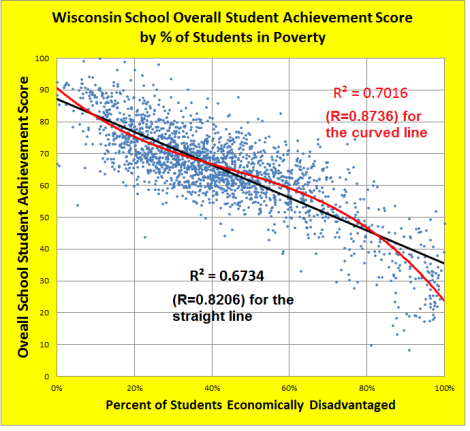"the single most important factor determining whether students succeed in school is not
the color of their skin or their ZIP code or even their parents’ income—it is the quality
of their teacher.”
This is, of course, a straight-out lie. Unfortunately, lies this convenient are zombies that need to be disproved over and over again. I recently saw, on the blog of a retired math teacher, a graph that (re-)does the job quite neatly.
The graph, gratefully reproduced below, shows very clearly the relationship between poverty and educational achievement.
The state of Wisconsin makes available a lot of data about all of its schools, and the retired math teacher blogger has made a chart comparing the average "student achievement score" for a school (a composite of the math and reading scores on the state tests for all students in a school) with the % of students who are eligible for free or reduced-price lunch. Each blue dot represents a school; its vertical position represents student achievement, while its left-right position represents the % of "economically disadvantaged students." (The curved lines are the first and third-degree functions that fit the data best--you can ignore them if you like.)
 |
| (From http://gfbrandenburg.wordpress.com/2013/01/21/poverty-isnt-destiny/) |
What I like about this graph is its beautiful symmetry. Look at the top left hand corner of the graph, and you will see that there is not a single rich school (i.e. less than 10% of students eligible for free or reduced price lunch) in the entire state of Wisconsin whose "student achievement" the state measures at less than 54. Similarly, there is not a single poor school (i.e. FRPL>90%) whose student achievement is above 53. In other words, there is ZERO overlap between the rich schools and the poor schools.
This graph, like the compelling ones compiled by UT physicist Michael Marder, shows that in the real world there is no school--not a single one!--that has succeeded in educating its poor kids to the level of even the lowest-achieving rich-kid schools. It may be theoretically possible, but as far as I can tell it has never been done, and to say, as Klein, Rhee and their ilk do, that "the single most important factor" determining success in school is not parental income but teachers is offensive to teachers, to kids, and to anyone who cares about truth, science, data, or reality.
No comments:
Post a Comment